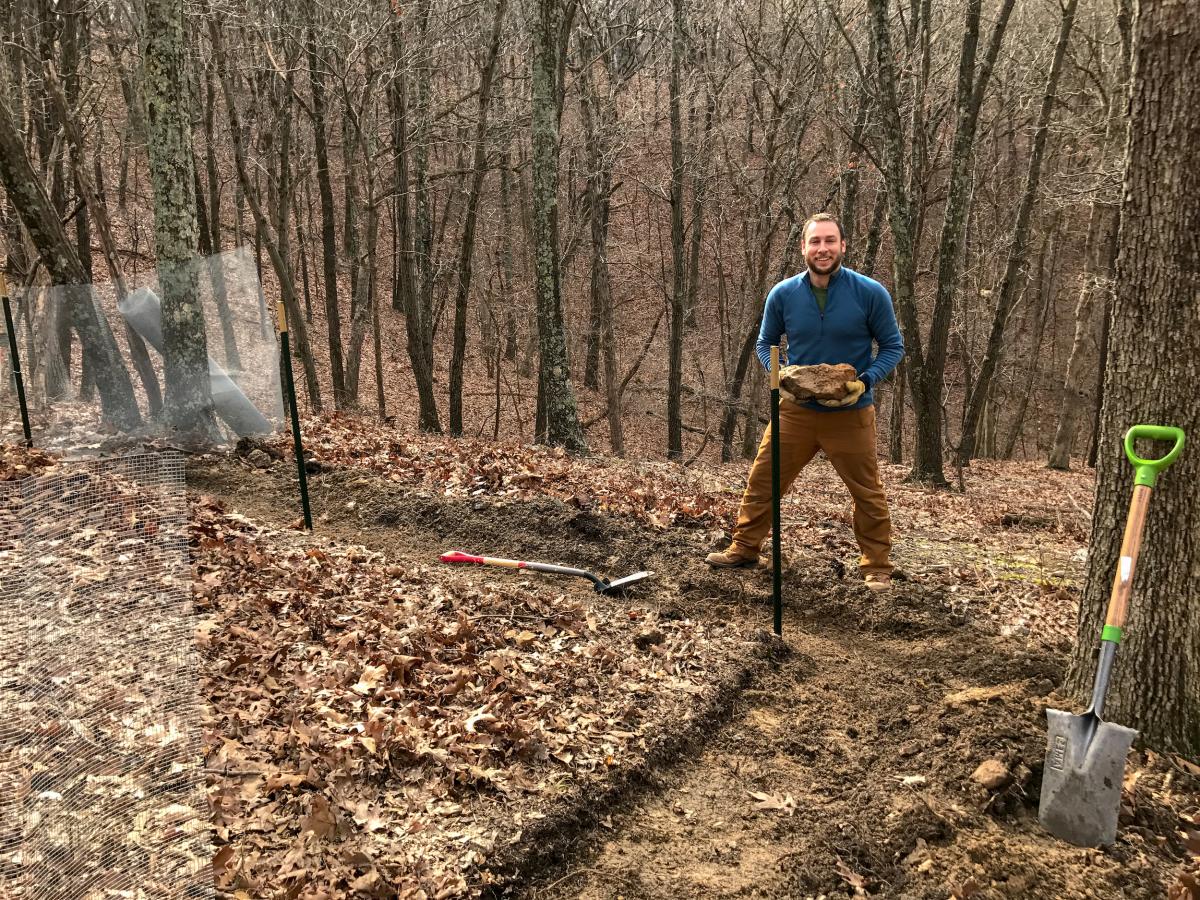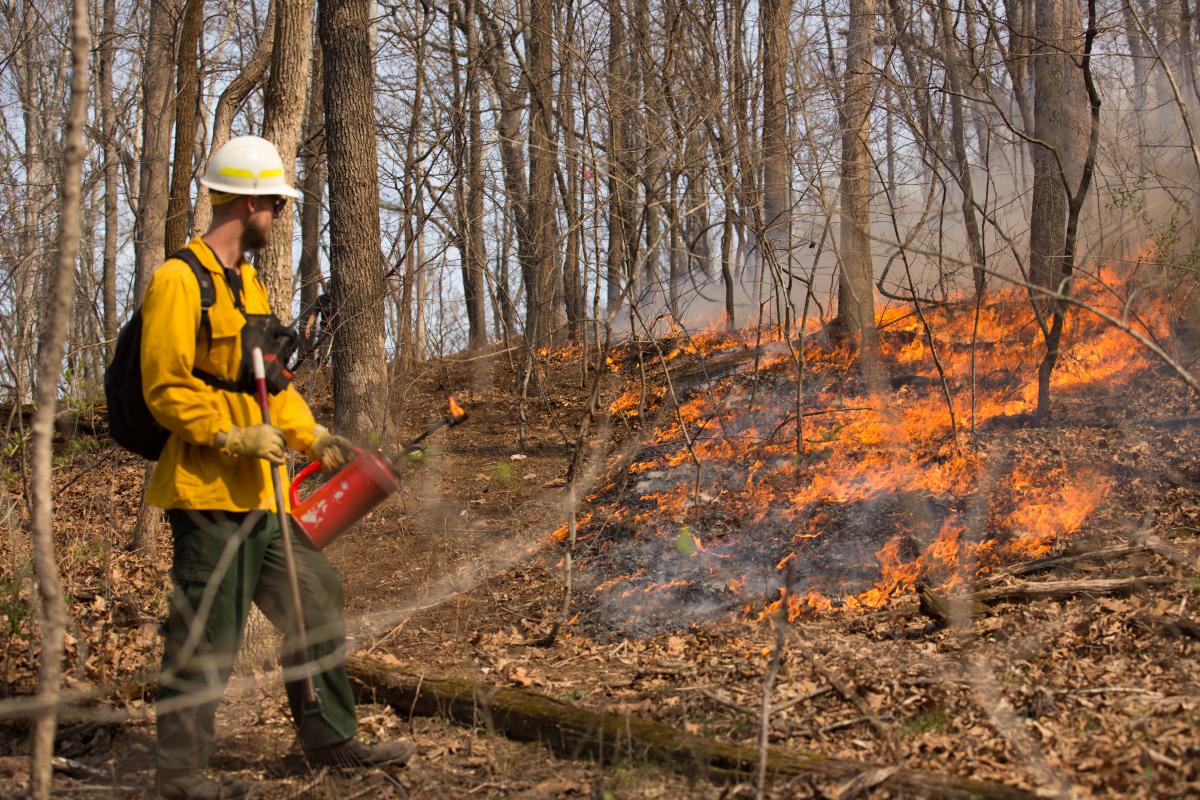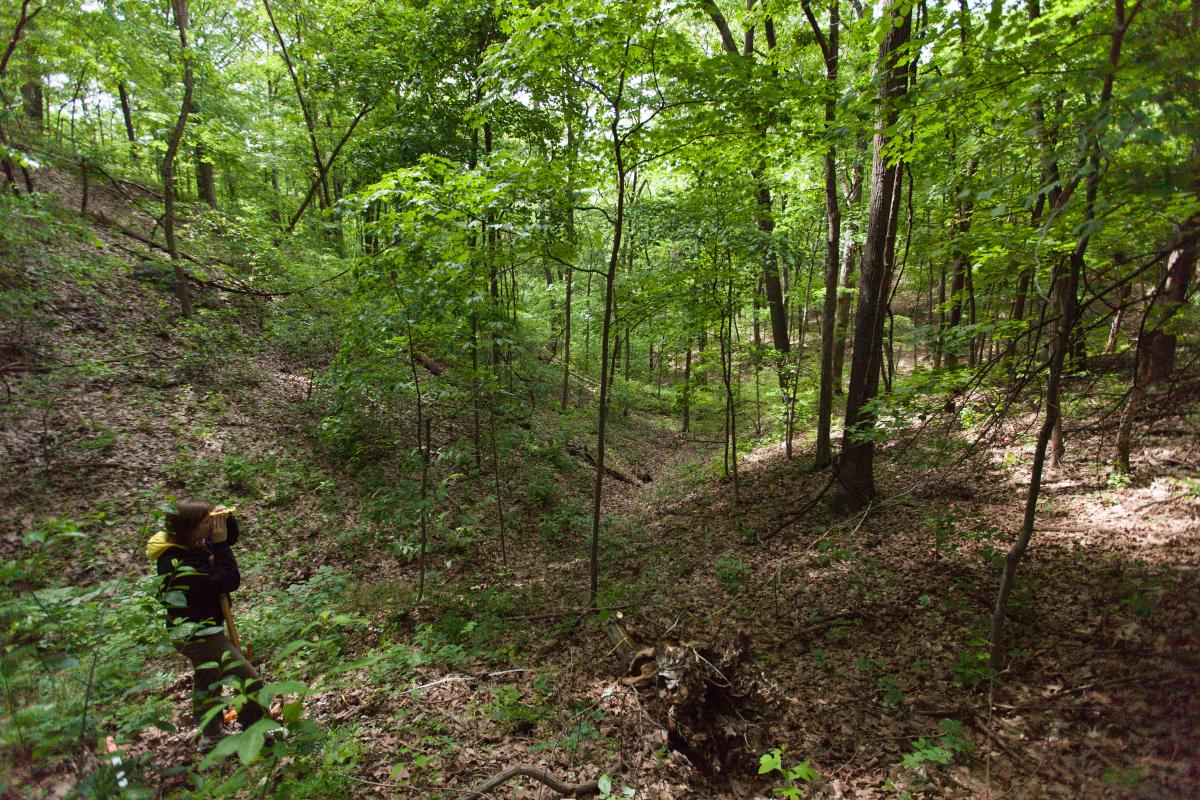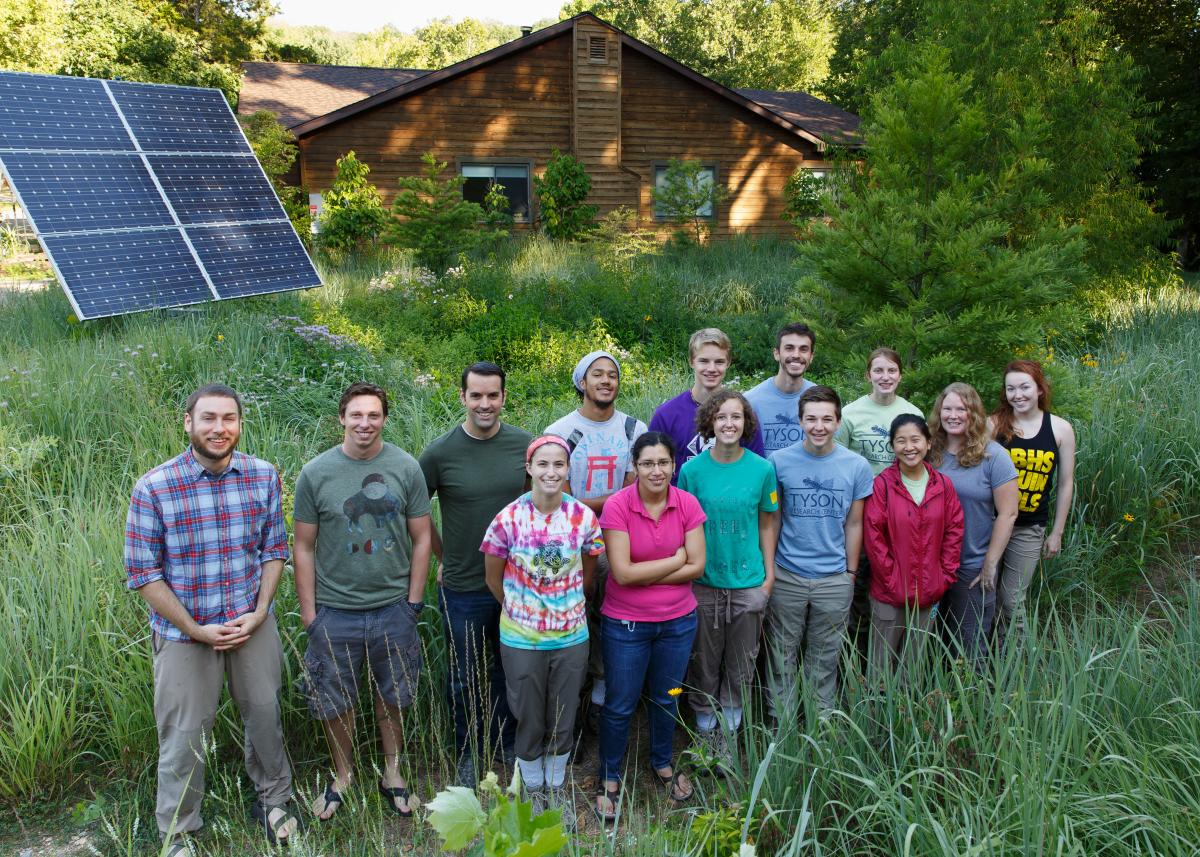Spotlight Series: Jonathan Myers & the Tyson Research Center FDP of the Ozark Highlands (USA)
Jonathan Myers has long been interested in forest ecology and natural history. He is an Associate Professor of Biology at Washington University in St. Louis and PI of the Tyson Research Center (USA) FDP, a plot that he expanded from its original 4-ha to its current 20-ha as part of his post-doctoral research in 2010. Jonathan enjoys traveling widely, has visited nine ForestGEO sites, and takes beautiful photos of forests, his travels, and everyday life.
When did you realize you wanted to be a scientist/work in forest ecology? How did you decide to go down this career path?
A few key moments come to mind. In high school, I completed a two-year, hands-on career-training program in natural resources conservation that sparked my interest in environmental education, forest ecology, and conservation. As part of the course, each student created a dendrology book that included pressed leaves and twigs collected from local trees and a description of the natural history of each species. I quickly fell in love with botanical collections, plant identification, and natural history. At Paul Smith’s College (a small private four-year college with a 14,000-acre campus in the Adirondack Mountains), I majored in forest recreation and began exploring careers in outdoor education as a forest or park ranger. I also had the opportunity to work in a dendrology laboratory with Michael Kudish, an outstanding professor, mentor, botanist, and forest historian who had been conducting fascinating research on the historical ecology of forests in the Adirondack and Catskill Mountains of New York. During my summers in the Adirondacks, I gained experience working as a botanist for the U.S. Forest Service on a large-scale forest-ecology experiment, as an interpretive naturalist at a state park, and as an instructor for a forest mensuration course at Paul Smith’s College. These experiences piqued my interest in becoming a professor. At Cornell University, I majored in biology (ecology & evolutionary biology concentration) and completed an undergraduate honors thesis on long-distance seed dispersal by a dominant herbivore in eastern North America (white-tailed deer) under the mentorship of Peter Marks and Mark Vellend, two outstanding plant ecologists. In addition, I completed a research internship in tropical forest ecology in Panama, where I lived on Barro Colorado Island for a summer and collected tree-growth data in the Gigante Fertilization Experiment. In graduate school, I was fortunate to be mentored by Kaoru Kitajima and Kyle Harms, two inspiring plant ecologists and tropical biologists. Through a variety of early research and teaching experiences, I became fascinated with the ecology of temperate and tropical ecosystems and decided to pursue an academic career.

What has been your biggest challenge in getting to this point in your career?
As the first person in my family to pursue a Ph.D., one of my biggest challenges in getting to this point in my career was navigating the path to becoming a professor. Advanced math and science classes, as well as research, were all new and intimidating to me as an undergraduate student. Fortunately, with so many great mentors to help guide me in the right directions over the years, I did not get too lost along the way.
When did you first get involved in the ForestGEO network?
I first became involved in ForestGEO research around 20 years ago. After graduating from Cornell in 2002, I worked as a summer research assistant at the Institute of Ecosystem Studies on a long-term study of seedling diversity and dynamics in the Luquillo ForestGEO plot in Puerto Rico. In 2003, I returned to Barro Colorado Island (BCI)—following my first visit to BCI as an undergraduate research assistant in 2001—for my first field season as a graduate student in Kaoru Kitajima’s lab at the University of Florida. In 2010, I started my postdoctoral research at Washington University and initiated the establishment of a temperate ForestGEO plot at Tyson Research Center.
What is the most interesting or unique aspect of your site?
Two aspects stand out. First, Tyson Research Center (TRC) provides a unique setting for ecologists to explore multi-scale questions by coupling long-term observational studies with landscape-scale experiments. For example, my research team recently established a network of 16 large (1.4 ha) experimental-forest plots across the TRC landscape, outside of the TRC ForestGEO plot. The experimental-forest plots include factorial manipulations of fire disturbance (prescribed burns & unburned controls), seed dispersal, natural enemies (mammal exclusion), and plant-functional diversity to study mechanisms of forest diversity and dynamics. At the whole-plot scale, we census trees in the experimental-forest plots using ForestGEO protocols, thereby facilitating long-term comparisons with forest dynamics observed in the TRC ForestGEO plot. TRC is also the only ForestGEO site located in the Ozark Highlands ecoregion of the United States.

Second, the TRC plot has an interesting historical connection with the first plot in the ForestGEO network, Barro Colorado Island (BCI). The first 4-ha section of the TRC plot was established in 1981, the same year in which the BCI plot was established in Panama. The timing was not a coincidence. The 4-ha plot at TRC was established and censused by Carol Hampe, a Master’s student in Victoria Sork’s lab at University of Missouri-St. Louis. Inspired by the pioneering efforts of Stephen Hubbell and Robin Foster to establish the BCI plot, Carol and Victoria decided to establish a stem-mapped temperate-forest plot that would be comparable to the BCI plot. Carol’s thesis research documented numerous patterns that continue to be of widespread interest in ecology, including habitat associations, patterns of relative species abundance, spatial aggregation of common and rare species, species-area relationships, and tree-size distributions.
This video, produced in 2013 when the Tyson Research Center FDP joined the ForestGEO network, explores the plot’s history and introduces its methodology.
What questions are you currently addressing in your research/site?
My current research explores two themes in community ecology—1) community assembly from local to global scales and 2) biodiversity responses to environmental change—across a variety of ecosystems. Over the last 10 years, my research group has explored these topics using a combination of observational studies and field experiments in sub-tropical longleaf pine ecosystems in the southeastern United States, temperate and tropical forests across the ForestGEO network, tropical forests across elevational gradients in the Andes Mountains, and plant-pollinator communities in the Northern Rocky Mountains. Our current projects on community assembly explore the relative importance of dispersal-assembly and niche-assembly mechanisms across diversity gradients, the role of species-pool functional diversity in determining patterns of biodiversity across spatial scales, demographic and community-level outcomes of local species interactions across biogeographic and environmental gradients (e.g., plant-enemy & plant-pollinator interactions), and the eco-evolutionary assembly of local communities and regional biotas across elevational gradients. Our current projects on environmental change focus on fire disturbance as a driver of biodiversity across spatial scales. These projects examine biodiversity responses to changes in wildfire severity in the Rocky Mountains, prescribed fires in the hyperdiverse and fire-maintained longleaf pine ecosystem, and ecological restoration of forest-savanna ecosystems with prescribed fire in the Missouri Ozarks.


What kind of capacity building opportunities does your site provide for students, early-career researchers, and the local community?
As the environmental field station of Washington University, Tyson Research Center (TRC) provides abundant opportunities to integrate ecological research, education, and community outreach. The infrastructure and educational programs at TRC facilitate large-scale and long-term research projects, teaching opportunities, and collaboration across disciplines, institutions, and levels of academic training. TRC provides unique research experiences for both high school and undergraduate students. Through the Shaw Institute for Field Training (SIFT) and Tyson Environmental Research Apprenticeship (TERA) programs, St. Louis area high school students explore environmental biology careers and conduct research with TRC educators, scientists, and their teams. Through an 11-week Tyson Undergraduate Fellows Program, undergraduate students are given the opportunity to work elbow-to-elbow with a faculty or staff principal investigator, post-doctoral scientist, or graduate-student mentor on current Tyson-based research projects. Over the last 10 years, 60 high school students from 25 high schools and 45 undergraduates from 11 colleges and universities have conducted field research in the TRC ForestGEO plot.
In the last three summers, the TRC Science Communication Team has conducted a “Humans of Tyson” Project to convey personal stories of experiential learning, perseverance, humor, research activities, reflection, and community support through photo portraits and interviews.

What is your favorite part about your work?
I especially enjoy working with great people in great places and exploring questions across a diversity of ecosystems. I have been fortunate over the years to collaborate with many excellent colleagues and mentors, postdocs, graduate students, and undergraduates. Several of these collaborations have allowed me to expand the conceptual, geographic, and taxonomic scope of my research into exciting new areas, including two global biodiversity hotspots—the Andes Mountains and Longleaf Pine Ecosystem—as well as the Rocky Mountains and other forest ecosystems around the world through collaborations with the ForestGEO network.
What do you like to do when you’re not studying forest dynamics?
I enjoy travel, collecting music from the world, photography, biking, birding, hiking, fly-fishing, soccer, and chess, and of course, visiting other ForestGEO sites. Through collaborations, ForestGEO workshops and research trips, I have enjoyed exploring several ForestGEO sites (BCI, Danum Valley, Hainan, Luquillo, SERC, Wind River, Yosemite, Xishuangbanna, Zofin), and look forward to visiting many more sites in the future.
Web Presence
Myers Ecology Lab | University Profile | Photography | ResearchGate | Twitter | Google Scholar
Select Publications
Catano, C. P., T. L. Dickson, and J. A. Myers (2017) Dispersal and neutral sampling mediate contingent effects of disturbance on plant beta-diversity: A meta-analysis. Ecology Letters 20: 347–356. https://doi.org/10.1111/ele.12733
LaManna, J. A., S. A. Mangan, A. Alonso, N. A. Bourg, W. Y. Brockelman, S. Bunyavejchewin, L-W Chang, J-M Chiang, G. B. Chuyong, K. Clay, R. Condit, S. Cordell, S. J. Davies, T. J. Furniss, C. P. Giardina, I. A. U. N. Gunatilleke, C. V. S. Gunatilleke, F. He, R. W. Howe, S. P. Hubbell, C-F Hsieh, F. M. Inman-Narahari, D. Janík, D. J. Johnson, D. Kenfack, L. Korte, K. Král, A. J. Larson, J. A. Lutz, S. M. McMahon, W. J. McShea, H. R. Memiaghe, A. Nathalang, V. Novotny, P. S. Ong, D. A. Orwig, R. Ostertag, G. G. Parker, R. P. Phillips, L. Sack, I-F Sun, J. S. Tello, D. W. Thomas, B. L. Turner, D. M. Vela Díaz, T. Vrška, G. D. Weiblen, A. Wolf, S. Yap, and J. A. Myers (2017) Plant diversity increases with the strength of negative density dependence at the global scale. Science 356: 1389–1392. https://doi.org/10.1126/science.aam5678
Myers, J. A., J. M. Chase, I. Jiménez, P. M. Jørgensen, A. Araujo-Murakami, N. Paniagua-Zambrana, and R. Seidel (2013) Beta-diversity in temperate and tropical forests reflects dissimilar mechanisms of community assembly. Ecology Letters 16: 151–157. https://doi.org/10.1111/ele.12021
Myers, J. A., and K. E. Harms (2011) Seed arrival and ecological filters interact to assemble high-diversity plant communities. Ecology 92: 676-686. https://doi.org/10.1890/10-1001.1
Spasojevic, M. J., C. P. Catano, J. A. LaManna, and J. A. Myers (2018) Integrating species traits into species pools. Ecology 99: 1265–1276. https://doi.org/10.1002/ecy.2220
Vela Díaz, D. M., L. Cayola, A. F. Fuentes, L. R. Malizia, C. Blundo, and J. A. Myers (2020) Untangling the importance of niche breadth and niche position as drivers of tree species abundance and occupancy across biogeographic regions. Global Ecology and Biogeography 29: 1542–1553. https://doi.org/10.1111/geb.13139
